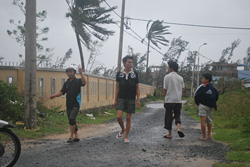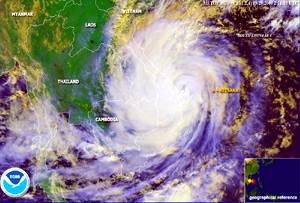|
|
Preparation
"Helped to Save Lives"
IRIN
September
30, 2009
Vietnam

Ngo Thi Thanh has weathered dozens of tropical storms and typhoons living in central Vietnam’s coastal region, but in her 60 years she has never seen the kind of destruction wrought by Typhoon Ketsana, which struck late on 29 September.
“It swept through just like an atomic bomb was dropped here,” says Thanh, who lives in Quang Nam, the hardest-hit province, on the south-central coast of Vietnam.
Her house, built of cement, sheltered dozens of friends and neighbours as 144km/h winds struck the town of Tam Ky, 7km from the coast.
“The storm is now gone but all the tin roofs were torn off and the streets are full of fallen trees,” says Thanh. “The city looks like it was just bombed.”
According to the government and the UN, 41 people were killed and 10 people are still missing.
Nearly 60,000 homes were either damaged or destroyed. Sections of the ancient town of Hoi An, a UN Educational, Scientific and Cultural (UNESCO) World Heritage site, remain under 3m of water.
Ugo Blanco, who is helping to coordinate the UN Development Programme’s response to the storm, says the casualty figures could have been much higher.
“The typhoon was one of the worst in intensity, but not in terms of damage,” says Blanco. This was because “preparation was very, very good. When the storm hit the Philippines it triggered preparations [in Vietnam]. Two hundred thousand people were evacuated. It saved many, many lives.”
While Typhoon Ketsana was downgraded to a tropical depression as it moved inland over Cambodia and Laos, residents and officials in central Vietnam are now battling heavy flooding.
At least one section of the national highway that runs north to south remains impassable.
Millions are without electricity after sections of the national grid were affected.
Nguyen Ngoc Quang, director of flood control and prevention in Quang Nam province, said rising waters, flooded roads and damaged bridges had isolated hundreds of thousands of people.

“We’ve mobilized soldiers to help deliver instant noodles, medicines and other supplies,” says Quang. “We won’t let people go hungry.”
Though the rains have tapered off, rivers in some areas are still rising. Levels are expected to exceed the high water marks during the historic floods of 1964, according to Nguyen Lan Chau, deputy director of the National Centre for Hydro-meteorological Forecasting. Flood warnings remain in effect, she says, and many more people may need to be evacuated if waters do not begin receding soon.
Quick response
Residents were moved inland and vulnerable buildings were boarded up and reinforced with sandbags. Katsana killed at least 246 people in the Philippines before moving into the South China Sea.
The Disaster Management Working Group, comprising representatives from the government, UN and NGOs, are sending teams to the six provinces hardest hit to assess the damage. They will issue their report, which will include recommendations for long-term relief and recovery projects, next Tuesday.
“We are now very scared,” says Thang of Tam Ky. “The worry is that another storm will come and we won’t have enough time to physically and [emotionally] recover.”
|
|



